
Today’s grooming scene blends clean barbering with playful trends. Asian men are shaping looks that balance neat cuts and bold moves. K‑Pop idols and street fashion push center parts, soft fringes, and sleek finishes into everyday style.
This guide is a listicle so you can jump to the looks that fit your life. Whether you need a low-maintenance weekday cut or a statement change for the weekend, the options range from short crews and two‑block cuts to textured perms and long, controlled waves.
Each entry shows how a barber can adapt a haircut to your features and routine. You’ll learn which products—pomade, clay, wax, or texture powder—match your desired finish. Expect pro tips you can use when you book a consultation.
Key Takeaways
- Trends mix classic barbering with K‑Pop and street influences for versatile looks.
- Find styles that suit workdays and weekend fashion without extra effort.
- Barbers tailor cuts to your face, hair type, and daily routine.
- Choose products to control separation, texture, or shine.
- Save ideas to show at your appointment for faster, reliable results.
Trending asian male hairstyles right now: from K‑Pop to street style
From curtain parts to textured spikes, today’s cuts favor contrast and movement. The two‑block dominates because a fuller top and clipped sides give a lightweight feel that still reads polished on camera.
Curtain bangs and the two‑block cut
Curtain bangs with a center part soften features and echo K‑Pop vibes. On straighter hair they fall neatly and need about 3–5 inches on top to part and air dry.
Wolf cut texture for modern edge
The wolf cut mixes short top layers for lift with longer ends for movement. Use a light cream for airy texture and ask your barber for scissor work on top to keep natural grain.
Spiky styles with tapered sides
Updated spikes pair a textured top with a low or mid fade. Aim for matte, piecey separation using texture powder or light clay—not stiff gel.
- Undercut or tapered sides sharpen silhouettes while preserving fringe softness.
- Keep drying low‑heat: diffuse or air dry to avoid frizz and keep movement.
- Small tweaks to the part or eye‑length fringe tailor the look to daily comfort.
| Style | Top Length | Best Product | Sides |
|---|---|---|---|
| Two‑block with curtains | 3–5 in | Light clay / fiber | Clipped, tapered |
| Wolf cut | 3–5 in | Cream for airy texture | Scissor‑tapered or soft undercut |
| Textured spikes | 2–4 in | Texture powder / light clay | Low/mid fade |
| Messy waves with fade | 3–5 in | Sea salt spray + cream | Undercut or tapered |
Short cuts with maximum impact
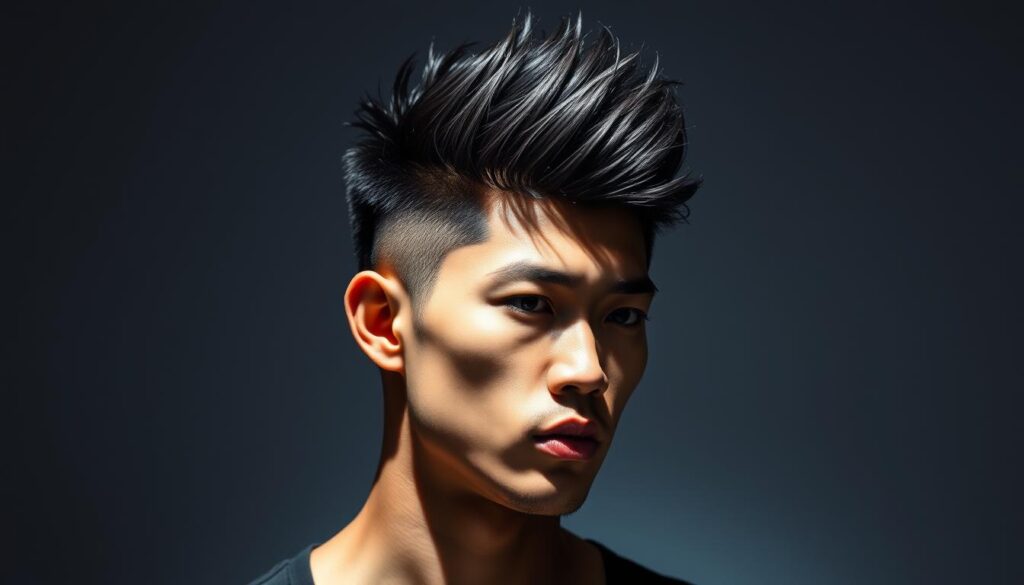
Short cuts pack bold personality into a compact silhouette that reads modern and clean.
Classic crew vs. long crew: the classic crew keeps the top short and neat. The long crew keeps a bit more length on the hair top and a jagged fringe for piecey texture and a youthful look. Use a matte clay or paste to keep separation without shine.
Buzz and high & tight: a buzz cut is fast, low-maintenance, and sharp. Personalize it with a low skin fade or uniform length all around. The high & tight gives very close sides and a compact top — ideal for humid weather and gym routines.
Modern bowl, tapered sides
Modernize the bowl by turning it into a two-block with tapered sides and a refined outline. This frames the top without a helmet effect and reads current with subtle contrast.
- Ask for scissor texturing on top to avoid a flat plane.
- Touch-ups every 3–4 weeks keep crews and high & tights crisp.
- First-timers can start longer on top and tighten sides over time.
| Short Cut | Top Length | Product | Maintenance |
|---|---|---|---|
| Classic crew | 1–2 in | Light pomade/clay | 3–4 weeks |
| Long crew with jagged fringe | 2–3 in | Matte clay/paste | 3–4 weeks |
| Buzz / high & tight | 0.5–1 in | None / light paste | 2–4 weeks |
| Modern bowl (two-block) | 1.5–3 in | Texture powder/cream | 3–5 weeks |
For a clear example of how the two-block modernizes the bowl, see this guide to a two-block haircut.
Medium‑length styles that balance volume and shape
Medium-length cuts hit the sweet spot between everyday ease and visible shape. These looks let you keep movement on top while maintaining a tidy outline at the sides and back. They work great for men who need a professional finish and weekend flexibility.
Side part with scissor-cut sides
Try a side part with scissor-cut sides for a boardroom-ready look that still moves after hours. Scissor work keeps density under control without the hard contrast of a clipper fade. Add a clean, shallow part line for definition that grows out gracefully.
Messy waves and textured brush-back
Textured brush-back styles use a blow dryer and a light cream to lift the top and keep the outline soft. Rough-dry to about 80%, set the part, then finish with a matte paste for crown volume.
Messy waves suit medium length because they use natural texture to create shape. If you want a slimmer profile, pair waves with a subtle fade or undercut. Keep the neckline tidy and schedule dusting trims to preserve the silhouette without losing length.
- Quick routine: rough-dry, set part, apply matte paste.
- Product tips: thicker asian hair may need stronger hold in humidity; finer hair prefers light creams for lift.
- Styling flexibility: comb over for formal events or loosen into waves for weekends.
| Feature | Use | Product |
|---|---|---|
| Scissor-cut sides | Professional balance | Light cream |
| Textured brush-back | Lift + soft outline | Matte paste |
| Messy waves | Casual volume | Sea salt spray / light cream |
Long hair looks: movement, flow, and finish
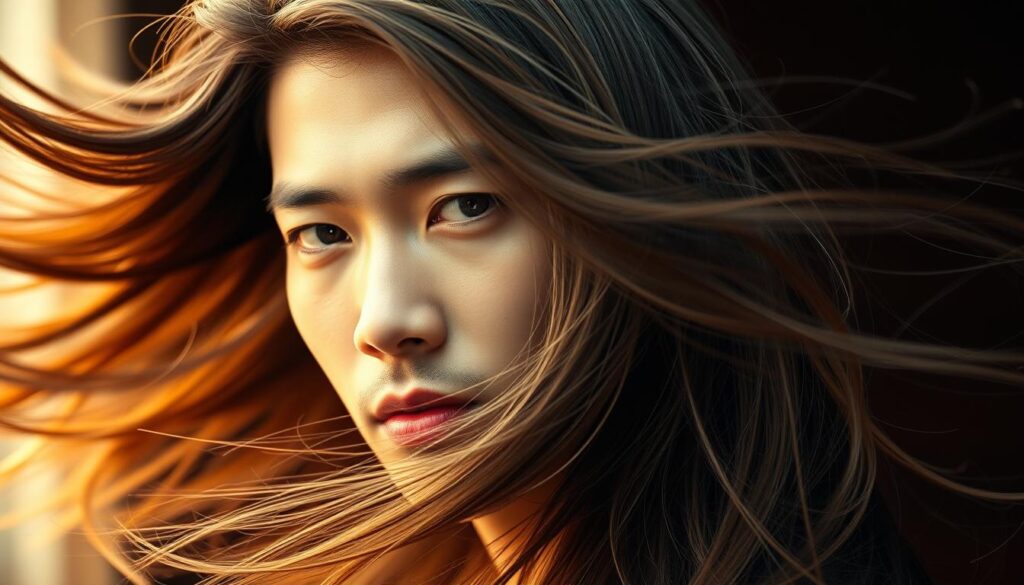
Keeping length lets texture and motion define your look, from loose waves to secured buns.
Surfer layers and low ponytail
Surfer layers add movement and lift while removing weight from the ends so long shapes don’t collapse at the back.
Try shoulder‑length waves with soft layers to keep flow and light bounce. For a sleeker day, gather hair into a low ponytail and leave soft tendrils at the temples for a relaxed, wearable finish.
Man bun and samurai bun variations
The man bun is looser and casual; it sits lower and reads effortless.
The samurai bun sits higher and tighter for a sharper, more intentional finish. Use a fabric hair tie to prevent breakage, especially during workouts.
Adding highlights or balayage for sun‑kissed dimension
Subtle highlights or balayage add depth and a sun‑lit appearance without a full color commitment.
Small contrast around the top and tips brightens the look and brings out texture. Keep a hydrating conditioner and occasional mask in your routine to maintain shine and manageability.
- Daily styling: a pea‑sized matte paste tames flyaways while preserving natural flow.
- Maintenance: trims every 10–12 weeks remove split ends and preserve length and movement.
- Neat outline: ask for a minimal taper at the nape if you wear a low ponytail to the office.
- Quick change: drop the ponytail and finger‑comb for an easy evening transition.
K‑Pop inspired haircuts that define the vibe
Idol-inspired cuts balance polished edges with airy layers for a modern, camera-ready finish. These looks lean on a clean part and soft movement to frame the face while staying versatile for work or stage.
Center‑part curtains (Jungkook‑inspired)
The curtain formula is simple: cheekbone‑grazing fringe with soft layers so the hair splits naturally at the center. Ask your barber for longer front pieces and light texturing to avoid a heavy plane.
Blow‑dry with the air directed down the strands, then pinch sections with a pea‑size amount of light paste to create separated bangs that move.
Color play and asymmetric shapes (G‑Dragon energy)
Introduce slight length differences or a razor‑cut panel for a subtle asymmetric edge. Semi‑permanent color or soft highlights test bolder tones while fading cleanly.
- Keep sides lightly tapered to avoid bulk and keep the top lively.
- Trim the fringe every 4–6 weeks to keep the curtain sitting at the eyes.
- Use a soft‑matte finish so the look reads natural on camera and in person.
- Protect color with a sulfate‑free shampoo to keep tone and moisture intact.
Fade, taper, and undercut fundamentals
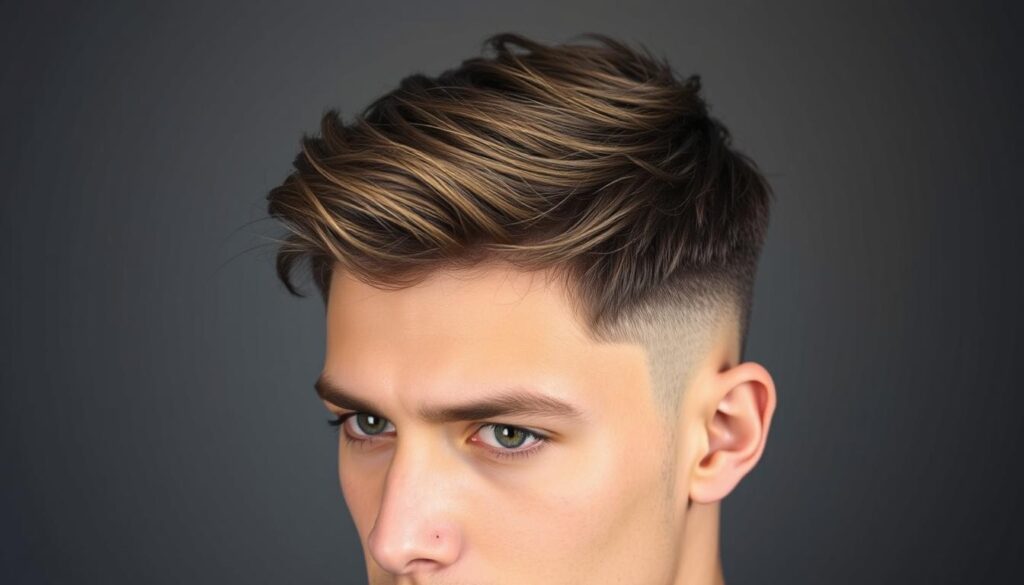
Fades and undercuts shape how the sides meet the longer hair on top and change your whole profile.
Fade height is the first decision to make. A low fade blends just above the ear for a professional, restrained finish. A mid fade offers balance between contrast and coverage. A high fade creates bold contrast and draws attention to the hair top.
Low, mid, high, and skin fades explained
Skin (bald) fades taper clean to the scalp for an ultra‑crisp outline that spotlights the top. Expect sharper grow‑out lines and more frequent touchups.
Low, mid, and high placements refer to where the fade starts. Say where you want the fade to begin so the barber matches your comfort with scalp exposure.
Disconnected undercut vs. blended taper fade
A disconnected undercut keeps a uniform short length on the sides under a longer top. It makes a dramatic step between lengths and suits textured crops and statement cuts.
A taper fade blends the sides smoothly into the top for a softer silhouette. Ask for scissor‑over‑comb on the blending area if you prefer subtle transitions.
- Why it matters: higher fades and shorter sides emphasize height and can slim the face in photos.
- Style pairings: low fades work well with side parts and business looks; high fades suit textured crops and street styles.
- Maintenance: skin and high fades need more frequent visits than low fades.
- Tip for the barber: bring reference photos and say “where the fade starts” and “how short the bottom goes.”
- Aftercare: use a soft brush daily to train the hair top direction so blends sit flatter.
| Fade Type | Start Height | Effect | Maintenance |
|---|---|---|---|
| Low fade | Just above ear | Professional, subtle contrast | Every 4–6 weeks |
| Mid fade | Between ear and temple | Balanced profile, versatile | Every 3–5 weeks |
| High fade | Above temple | Bold contrast, emphasizes top | Every 2–4 weeks |
| Skin (bald) fade | Tapers to scalp | Ultra‑crisp outline, very clean | Every 2–3 weeks |
| Disconnected undercut / taper | Varies by style | Sharp step vs. smooth gradient | Depends on top length |
For a visual guide and more technical descriptions, check common fade types.
Side part, comb over, and slick back classics
Clean side parts and swept backs give classic looks a precise, modern edge. The side part anchors a tidy silhouette and a shallow hard part adds definition that lasts until your next cut.
Gentleman’s hard part for a sharp finish
The gentleman’s hard part uses a defined parting line and a high‑shine gel or pomade for a crisp finish. Match fade height to formality: low fades suit office settings, while mid or high fades boost after‑hours appeal.
Textured comb over with volume on top
For a textured comb over, rough‑dry the crown for lift, then apply a light product for controlled volume on the hair top. A diagonal comb over toward the back can visually lengthen the head and flatter many profiles.
- Scissor‑cut sides keep natural movement and easier grow‑out.
- High‑density hair benefits from a vent brush and heat to build volume; finer hair needs lighter products to avoid collapse.
- Quick daily steps: rough‑dry back and away from the face, set the part with a comb, then add a fingertip of pomade for hold.
- Keep the neckline and around‑the‑ears tidy; trims every 4–5 weeks preserve the crisp part line and clean sides.
Texture-forward styles: quiff, faux hawk, and spikes
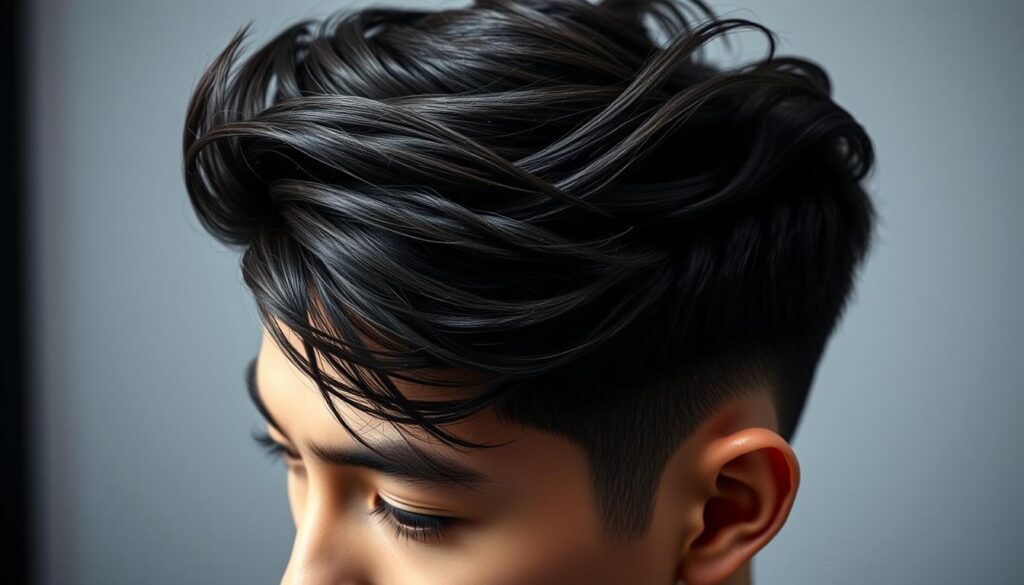
Buildable texture lets you switch from clean volume to a rough, edgy crest in minutes. These looks focus on lift at the top, smart fades at the sides, and a product choice that matches the finish you want.
How to craft the modern quiff
Rough-dry the top while lifting at the roots with a blow dryer. Pinch through the front to create a sculpted crest, then lock shape with a small amount of high‑hold pomade.
Faux hawk and spikes—quick styling notes
The faux hawk works best with a tidy high taper fade; style the center channel upward for attitude. For spikes, distribute product evenly, lift from the roots, and define a few peaks rather than spiking every strand.
- Top length: keep 2–4 inches for flexibility between quiff, light faux hawk, and spikes.
- Product choice: matte clays give gritty separation; high‑shine pomades create a sleek finish. Try Suavecito, Baxter of California, or Layrite for all‑day hold.
- Volume tip: use texture powder at the roots before finishing with a pea‑size amount of product.
- Refresh: mist with water and re‑pinch separation for a mid‑day revive; use a soft brush on the sides to keep the fade neat.
Rotate finishes—choose matte for daytime texture and a subtle shine for evening polish. For a practical example of a related cut that pairs well with these tops, see a guide to the two-block haircut.
Asian hair, face shape, and features: styles for round faces
Round faces benefit from cuts that add angles and lift. A few targeted choices at the fringe and crown shift the eye upward and slim the profile. These changes help the face read longer and more structured without heavy styling.
Short Caesar for structure
The short Caesar uses a horizontal fringe and tight sides to create clean planes that add definition to a round face.
Ask for tapered sides and a slightly longer top so the forehead line sits lower and the jaw appears sharper. Use a matte product to avoid shine across the brow and keep the front piece textured for movement.
Classic pompadour to add height and balance
A classic pompadour builds height through the front to elongate the face and refine overall appearance.
Request a low or mid fade to slim the sides while keeping the top proportionate. Subtle layering on top makes lift and styling easier with minimal product. Try a slightly off‑center part in pomp variants to break symmetry and flatter rounder features.
- Maintenance: edge cleanups every 3–4 weeks keep the outline crisp.
- Product tips: matte for the Caesar; medium‑shine for pomp when dressing up.
- Beard: a soft beard line helps define the jaw and balance proportions.
- Barber talk: discuss forehead height and crown growth so the top is shaped to your head.
- Bring photos: show pompadour sizes that match your daily routine—from subtle lift to event volume.
Perms, waves, and curls: building volume in straight Asian hair
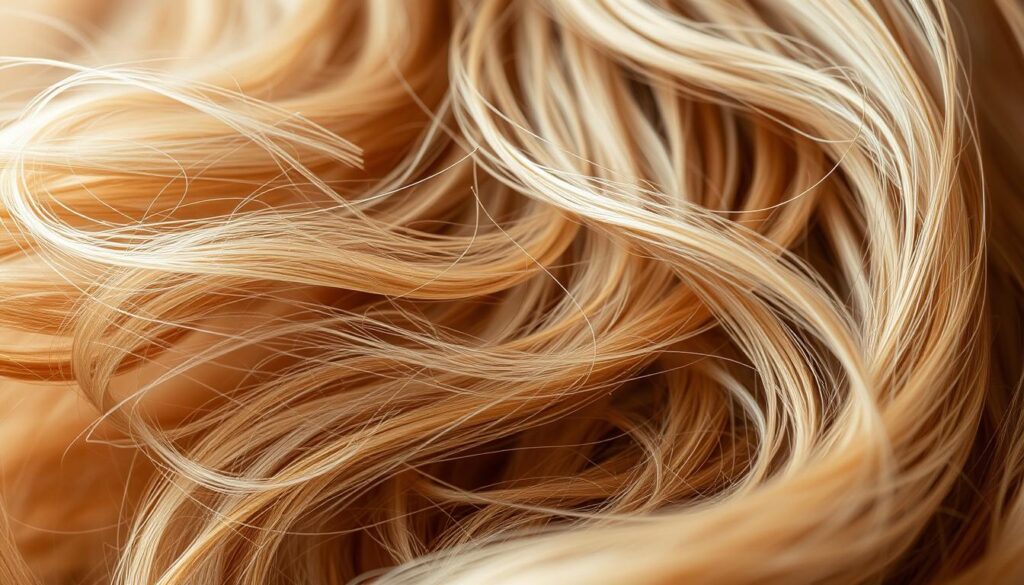
Perms and waves bring lasting body to straight strands that otherwise sit flat. Controlled texture adds movement on the top while keeping sides tidy. A well‑done perm holds shape longer between washes, so styling is simpler day to day.
Curly Korean perm for controlled texture
The Curly Korean perm creates soft, voluminous waves that suit many face shapes. Pair it with a tidy fade or tapered outline so the top reads fuller and the edges stay clean.
Tip: Ask for looser rods if you want a natural finish; choose tighter curls only for dense ringlets.
Wet permed mullet for statement styling
The wet permed mullet mixes beachy waves on the top with jagged, straighter length in back. This contrast makes a bold look without adding heavy length up front.
Perfom styling with a small amount of curl cream and diffuse on low heat for definition without crunch.
- Use curl‑friendly shampoo and avoid over‑washing to keep moisture.
- Expect touch‑ups every 8–12 weeks as new growth loosens the curl pattern.
- Keep product light—too much weight flattens the volume.
- Pinned or permed fringe and soft bangs frame the eyes without heavy bulk.
| Perm Type | Top Result | Best Pairing | Maintenance |
|---|---|---|---|
| Curly Korean perm | Soft waves, fuller top | Low/mid fade or taper | Touch‑ups 8–12 weeks |
| Wet permed mullet | Beachy waves + straight back | Undercut or tapered nape | Style every wash, trims 8–10 weeks |
| Loose rod perm | Natural, airy texture | Scissor‑textured top | Light product, monthly check |
Book a consultation to decide curl size and how the new texture fits your daily routine. A quick chat with your stylist prevents surprises and ensures the look matches your lifestyle.
Styling tips, products, and maintenance for Asian hair
A focused routine and a few solid products turn morning styling into a two‑minute win. Start by choosing the right finish: sleek, matte, or lifted.
Choosing pomade, wax, clay, and texture powder
Quick decision tree:
- Pomade — sleek control and shine; try Suavecito or Layrite.
- Wax — pliable definition for reshaping through the day.
- Clay — matte texture and separation on the hair top.
- Powder — instant root lift and lightweight volume.
Blow‑drying for lift, root volume, and direction
Aim airflow upward at the crown to build root volume. Rough‑dry until 80% dry, set the direction with a comb or fingers, then finish with a small amount of product for hold.
For longer hair, apply a leave‑in, air dry to about 70%, then use a fingertip of product to tame frizz and keep a natural finish.
Routine care: taper touch‑ups and keeping sides neat
Recut the sides and taper every 3–4 weeks to keep the outline sharp while the top grows. A scissor‑trimmed neckline grows out softer than a clipper box‑edge for classic styles.
Micro‑habits: brush nightly to train direction, sleep on a silk pillowcase, clarify monthly, and carry a travel powder for midday volume resets.
| Style | Product | Finish |
|---|---|---|
| Matte quiff / natural comb over | Clay | Matte, textured |
| Sleek slick back / side part | Pomade (Baxter) | Sleek, controlled |
Use less product than you think: emulsify in palms and layer if needed. For cut inspiration that pairs well with these routines, try the short wolf cut as a modern option.
Conclusion
A great haircut should simplify mornings and still let you change the vibe with small tweaks. From precise crew cuts to expressive longer hair and curtain bangs, choose a look that fits your routine and maintenance tolerance.
Try small experiments: adjust part placement or fringe weight, tweak fade height, or clean up the sides and top to refine shape. Start by mastering one hero product—like clay for weekdays—and add pomade for events.
Want ideas? Consider a subtle side part, a textured top with a soft fade, or a weekend man bun. For a layered, face‑framing option, check the Korean wolf cut.
Bring photos to your barber, book regular touch‑ups, and revisit these sections as the seasons change to keep your style fresh.
